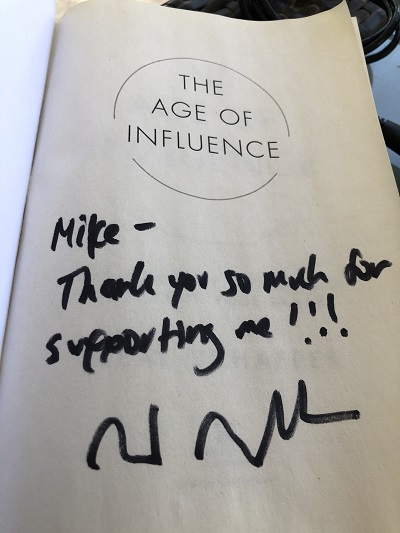
I’ve been following Neal, as a voice on marketing and social media, for easily 10 years.
When he announced the opportunity to buy his new book in advance, receive a signed copy, and be mentioned in the acknowledgments for to helping to support the book’s creation; I took him up on his offer – LinkedIn paying off once again.
You can find me mentioned, and neatly bisected, between page ix and x.
Fame at last.
I delve into this minutia because Neal’s book deals with, and makes the case for, influence and influencers. In how to both leverage and engage influencers in a successful business relationship, but also on how to be a successful influencer in the first place.
Influencer Marketing has received rather a bad wrap outside of the marketing world – particularly by the business community. This is mainly due to news stories of millennials traveling the world, and expecting hundreds of dollars in free goods and services in return for a good word on social media of dubious value. It is also not helped by stories of influencers using their networks to “take revenge” on businesses they feel slighted by; or who have spurned their advances.
“The Age of Influence” makes the case for influencer marketing to actually be an extension of normal social media engagement, taken to its next logical level. Those of us that have our own brands, and brands that we work for, on social know that our own personal posts are treated much more favorably by algorithm gods than brand business posts. It’s a “pay to play” world.
Influencer marketing leverages the personal voice for business purposes. Where “The Age of Influence” really succeeds is in showing the reader that influencer marketing should really be about the relationship between the brand, the influencer, and their larger social following. That the pinnacle of influencer marketing is not a paid Instagram post by someone famous. The pinnacle is rather the partnership, on a long-term basis, between a fan of a product or service, who also has their own fans who trusts the message because of the messenger. Trust is based on authenticity.
There is, of course, a tendency for brands to want to control their message, voice, and overall look. This is normal. As marketing professionals, we spend a lot of money, time, and energy into creating a look and personality for a brand that we are happy with. However, to do this with influencers is to stifle their natural creativity and voice that made them influencers in the first place. Likewise, influencers are not content creation adjuncts to the marketing department. Working with influencers, whose followings come in all shapes and sizes, is a partnership that could be allowing them to interview staff, get a sneak peek at a product or service, or giving discount codes, or products, to followers. The more successful the influencer, the more like working with a traditional media company the relationship becomes. But at its core, when influencer marketing is successful it is about a relationship where both parties are happy and getting what they want out of the collaboration.
There are significant legal issues with paid collaborations between influencers and brands. And while “The Age of Influence” does not deal with this in depth, it does warn of the pitfalls and make it clear that these are issues to address with any campaign that must be taken seriously.
“The Age of Influence” is much more than a “how to” manual of influencer marketing; it is a treatise on how influence is actually about boosting engagement and having a more dynamic relationship between customer and brand. How in its earliest of stages, influencer marketing is indistinguishable for just good social media engagement. As Neal states in the book, don’t get too focused on the tools; but the tools to get started are all in “The Age of Influence.”
If you feel that influencer marketing is not for you; “The Age of Influence” begs to differ, and if your interest is already there then it is the all-important bible.

